Single-payer health care has been proposed since the early 1990s as an alternative to our current, complex mixture of private insurance and governmental programs. Supporters of a single-payer plan contend that substantial savings can be achieved, while all residents are provided with appropriate health services.
In a single-payer health-care system, the government, either state or national, subsumes the role of health-care insurance companies. Instead of premiums paid by consumers to a company, which serves as the middleman for health-care services, a single-payer system is supported by taxes. All residents are covered regardless of income, employment or status of health. The central authority determines benefits, negotiates reimbursement for providers of services, manages all administrative responsibilities and monitors the system for cost and quality of care.
A recent study by Drs. Jodi Liu and Robert Brook in the Journal of General Internal Medicine analyzed 25 variations of single-payer health care. The authors found these examples in a detailed survey of legislative and academic proposals. The majority of plans offered public financing and universal coverage. Sixteen plans provided for voluntary insurance to cover additional services such as dental care. Plans varied in co-payments, mechanisms for controlling costs and benefits. A majority of proposals included clinical standards and guidelines and the means of monitoring compliance with these. This paper is a necessary starting point for any serious discussion of single-payer plans.
The Affordable Care Act of 2010 offered states the option of obtaining waivers for alternative health-care plans. With broad popular support, Vermont elected to implement a single-payer program. In 2010, the Vermont legislature established a commission to determine the best means for achieving this. In 2011, Green Mountain Health (GMH) was established in a party-line vote in the state legislature. Democrats supported the proposal. Republicans opposed it. A majority of the public supported GMH.
GMH would provide universal coverage. The plan would be financed by a 9.4 percent increase in payroll taxes and a 3.1 percent increase in personal income taxes. Further support was anticipated from federal programs. For example, GMH would receive federal funds that would otherwise support the state's Medicaid program. Tax increases would be less than the premiums paid to insurance companies. Yearly savings in total health-care expenditures were projected through simplified administration and controls on costs of services.
Estimated savings decreased over subsequent years, while projected tax increases to support the program steadily rose. Public support waned until less than half of citizens favored GMH. In December 2014, Gov. Peter Shumlin terminated GMH before it became a reality.
In 2016 Colorado voters rejected a single-payer proposal. Earlier this year, the California state senate passed a single-payer plan.
The organization, Physicians for a National Health Program (www.pnhp.org), offers a comprehensive single-payer proposal. The site provides a link to House Bill 676, Expanded Medicare for All Act, introduced in January 2017. The measure has 112 co-sponsors.
Opponents to single-payer plans cite a mistrust of government's ability to contain costs. They fear the creation and growth of a bureaucracy that would be beyond public control. Critics see an erosion of choice for patients in selecting their health-care providers and increasing wait times for care. The term "socialized medicine" is repeatedly injected into debate.
There are no simple solutions to a health-care system that many people deem dysfunctional. A single-payer alternative has growing support even if there is no agreement on what the term means. A unified, national program is essential for a single-payer plan to work. If each state is left to design its own health-care program, we will have chaos in our mobile society.
Congress owes us an open, informed debate of the options, their costs, what they cover and how they would be administered. Rigid ideologies should be left at the door. Until a comprehensive program is ratified, the Affordable Care Act of 2010 should remain in place with adequate funding.
Contact Clif Cleaveland at ccleaveland@timesfreepress.com.

